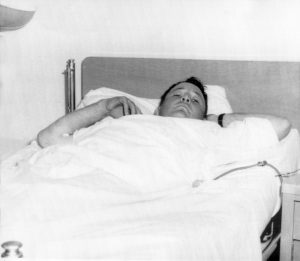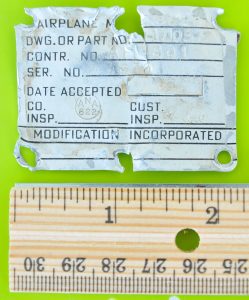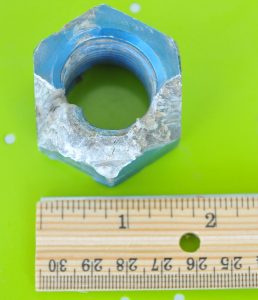At 11:50 AM on Monday 14th June 1954, a 31 year old Air Force pilot named Major Austin A Julian Jr (1922 – 2013) took off from Knoxville, TN headed for Columbus, OH in a US Air Force F-86E Sabre Fighter Jet. Major Julian had no idea that in less than an hour he would not be in Columbus as expected, but instead having coffee with Willa “Bill” Sexton (1902 – 2005) at her home on Garner.
Click on this link for an image of a restored USAF F-86E Sabre Jet Fighter.
At about 20 minutes past noon on 14th June 1954, fifteen-year-old Tommy Tiller was on his back porch of his home near the head of Rush Creek. He heard a loud and moving mechanical noise nearby, a very loud crashing sound, then nothing. Two other local teenagers soon joined Tommy at his house. There is some confusion as to who these other two teenagers may have been with possibilities being Billy Jarrell, or Billy Holley, or some Alexander. This trio scurried to the top of the hill directly in front of Tommy’s house and in the direction of the loud crashing sound. They saw smoke coming from below the hilltop, and it was very near. They headed directly toward that smokeTiller.
While Tommy Tiller and friends were climbing that hill to determine the source of that crashing sound, Major Julian had already floated earthward for a rendezvous with a large tree in Sexton Hollow off Garner that would entangle his parachute and temporally leave him dangling.
Within 20 minutes from when Tommy had first heard the loud crash from his back porch, the teenage trio had dropped down off the vantage point hill towards the smoke into a hollow called “Hickory Tree” and had located the exact source of the loud crash. This “over hill”, straight line, direct path to the crash site was only 0.5 miles from Tommy’s house. This teenage trio was the first on the scene. The smoking source was Major Julian’s crashed jet that had drilled itself into the earth in Hickory Log Hollow and disintegrated on impact. The impact had created a crater on the left hand side of Hickory Log Hollow about 50 feet above the small creek that flows from that hollow. Within a few minutes others arrived at the crash siteTiller.
Major Julian managed to free himself from the tree and walked south down the hill toward the mouth of a small hollow called “Sexton Hollow” that terminates on Garner Creek. In a short distance he encountered “Bill” Sexton’s house. Major Julian indicated “the lady asked me in” and gave him ice water and coffee “and wanted to know if I would like to lie down”ADI, June 15, 1954.
Major Julian was transported to Cattletsburg, KY by Bill Sexton’s neighbor on Garner, G R Broughton, then taken to Kings Daughters Hospital in Ashland, KY via a Kilgore and Collier Funeral Home owned ambulanceADI, June 15, 1954. His injuries were minor abrasions and contusions and he was quickly transferred to an Air Force Hospital at Lockburne Air Force Base near Columbus, OH. He was released two days later on June 16thUSAF Report. Here is an image of Major Julian in his hospital bed at Kings Daughters.

As you might expect a jet crash at the head of Rush created quite a local stir.
Thirteen year old Curtis Hamilton of Four Mile Creek lived on the other side of the hill from where Major Julian’s parachute had came to rest in that tree in Sexton Hollow off Garner Creek. Earlier Curtis had decided to walk to the nearby Ross Grocery at the intersection of Trace Road and US 23 (now KY SR3) and had missed the intrigue of seeing a parachuting pilot very near his house. But the rest of his Hamilton family had seen that parachute. So the entire Hamilton family, including the family dogs, headed on foot directly toward that parachute’s landing point. When Curtis arrived home from the store there was nobody there, not even the dogs. In his 13 previous years this had never happened. He had never encountered a totally empty house with no idea where everyone went. He thought possibly the Biblical Rapture had occurred and his family, including dogs, had descended to Heaven and he was left to fend for himself. This thought quickly evaporated when the family, with dogs in tow, returned after deciding not to walk over the large hill separating Four Mile Creek from Sexton HollowHamilton.
But Curtis Hamilton’s friend and neighbor, 9 year old Ken Young, did venture over that hill from Four Mile to Sexton Hollow and saw the parachute stuck in that tree, but Major Julian had already extracted himself. Ken also visited the parachute site the next day, but by then the parachute was goneHamilton.
Click on this Google Maps link to see where Major Julian’s landed in Sexton Hollow, now called Middleton Lane, at the red teardrop marker. The house about 500 feet due south of the red teardrop marker is where “Bill” Sexton lived and were Major Julian had his midday coffee. The approximate location of the parachute entangling tree is GPS 38.306528, -82.726722.
Google Maps Link to the approximate parachute landing point.
The crash scene as described by the Ashland Daily Independent on 15 July 1954:
“The plane apparently exploded when it hit trees and ground. Debris was scattered over an area covering a radius of 100 feet. What remained of the motor following the explosion was buried into a hole about 15 food deep and 10 feet in diameter. At 2:40 PM the motor continued to rumble at intervals, sounding like wind blowing the flames of a candle”.
The crash scene as described in the official US Air Force Crash Inquiry:
“The aircraft crashed on the property of the Eastern Kentucky Lumber and Development Company about 3 miles from where the pilot landed. The aircraft was observed to been in a right descending turn prior to the crash and was apparently not on fire. Airplane hit at a 45 degree angle and exploded on impact. Aircraft was completely destroyed and debris was scattered in a radius of 400 yards. Examination of the charred remains of the wreckage did not indicate fire prior to the crash.”
Here is a diagram of the crash site from the US Air Force Crash Investigation Report.
Curtis Hamilton did get in on the crash excitement a bit later in the day on July 14th when his Father, Charlie Hamilton (1912 – 1999), drove Curtis, Curtis’ older brother Bob Hamilton (1936 – 2003), and David Pope (Curtis’ 14 year old 1st cousin) to the crash site. Curtis indicated he was jerked away from his keen viewing location at the very edge of the smoking crater created by the still moving jet engine by a KY State Trouper that was very displeased with his vantage point. Curtis estimated the crater created by the engine at about 6 feet deep with the engine a foot or so below the surface and about 15 feet in diameter. This was such fun that these teenagers (Curtis, Bob, and David) returned the next day by riding their bikes the 5 miles from Four Mile Creek over Rush Hill to visit the crash site again, then void of other spectators and bossy KY State TroopersHamilton.
The GPS of the crash site is: 38.316420, -82.789440
The crash site is located at the red teardrop in this Google Maps link.
The plane did damage to the property of Eastern Kentucky Lumber and Development Company. There was destruction of 10 or 12 trees and a “laceration to the land primarily confined to a hole 5 feet deep and 18 feet in diameter”. They were compensated $150.00.
Click on this link to see the Air Force “Statement of Damage to Private Property”.
It seemed that everyone in the area had a souvenir piece of that crashed jet. Bob McGlothlin of Garner ( b 1935) had the pilot’s ejector seat that he had found. Raymond Burton’s (1914 – 1968) sons Corky (1936 – 1996) and Bobby Jack (b 1937) from Norton Branch carted home pieces that hung in Raymond’s smokehouse for decades. Charles Shockey (b 1941) ended up with that missing parachute. My own Father, George Coleman (1912 – 1991), had a couple of blue anodized aluminum pipe fittings in his top chest of drawers. More than one local were rumored to have stashed away machine guns from the wreckage. Below are three images from scavenged wreckage of Curtis Hamilton’s that I recently photographed (click on the images for a larger view).



The Air Force Report on the crash included statements from several eye witnesses from Rush, KY and a statement from the pilot, Major Julian. Note there are many aspects of these Rush resident’s statements that seem odd. One example is the use of the word “mountain” to describe a hill by Mae Coleman. No person of the area would refer to the local hills as mountains. So I am convinced that these statements were constructed by Air Force investigators based on information provided by the particular resident informant, and are likely representative of the local informant views but they are definitely not the actual words of the local informants. Click on the name links below to read these statements. Note that George Davis is Mae Coleman’s brother, and Dan Coleman is Mae Coleman’s Son.
Rush Residents Statements:
Curtis “Leo” Alexander (1919 – 1976)
Image of charred paper retrieved by Paul Hutchinson
Pilot Austin A Julian Jr (1922 – 2013) Statement
The USAF crash report indicated the cause of the crash was “loss of pitch control which resulted in uncontrollable maneuvers”. The loss of pitch control was due to a failure in the “elevator control system”, and specifically “the malfunction or material failure of the elevator control system was the probable failure of the artificial feel bungee causing exaggerated response of the elevator when applying normal stick pressure for elevator control”. Click on the links below for the USAF Boards “Findings , Conclusions, and Recommendations” and the “Closing Statement” summary of the crash by Colonel Paul P. Douglas.
USAF Board Finding, Conclusions, and Recommendations
“Closing Statement” summary of the crash by Colonel Paul P. Douglas
The pilot, Austin A Julian Jr, enjoyed a successful 29 year career with the US Air Force and retired a Lieutenant Colonel. He died in 2013. Click on the link below for additional information about the life of Austin A Julian Jr.
Link to obituary with a short personal history of the pilot, Austin A Julian, Jr.
A big thanks to Curtis Hamilton, Ken Young, Tom Tiller, and Mike Dixon for their kind help on this article.
Next Article – Hammond Hollow – Rush, KY
Previous Article – Visit to Site of 1954 USAF Fighter Jet Crash at Head of Rush, KY
Enjoy! Lon

I was so thrilled to come home on Memorial Day and receive a message from Lon Coleman about my father, Austin Julian. The day before I had been to visit my dad’s grave at the Veteran’s Cemetery. It is such a touching place with rows and rows of flags marking each grave. My father was a veteran of WWII, Korea (where he was in a dogfight and shot down a MIG fighter jet), and Viet Nam. During his 29 years of service to our country, my dad, known as “Gus” Julian served as an experimental test pilot (these are the men who deliberately put fighter jets into perilous situations so that they can write the official manuals for pilots–very dangerous duty), and was Deputy Commandant of the Aerospace School (where all astronauts and test pilots train). One of his many accomplishment was flying over 118 aircraft (most USAF pilots only get OKed for two or three), and completing the initial testing of in-flight refueling.
My dad was born in Roan Mtn, Tennessee which is right on the Tennessee-North Carolina border. He had just left Tennessee after visiting with his family and was on his way to Ohio when the malfunctioning of the Saber Jet occurred. After sharing this story with one of my sisters, she reminded me of a story handed down to us about it. Apparently, one of the local gentlemen came to look at the crash site and laconically drawled out in amazement, “So this is what a jet looks like . . . ” Of course, it had been smashed into a million pieces and was hardly recognizable.
Thanks so much again,
Susie Sommerkorn , daughter of Austin “Gus” Julian, Jr.
Susan, Thank you so much for this generous comment. Your detailed information about your Father really helps with this story. Enjoy! Lon